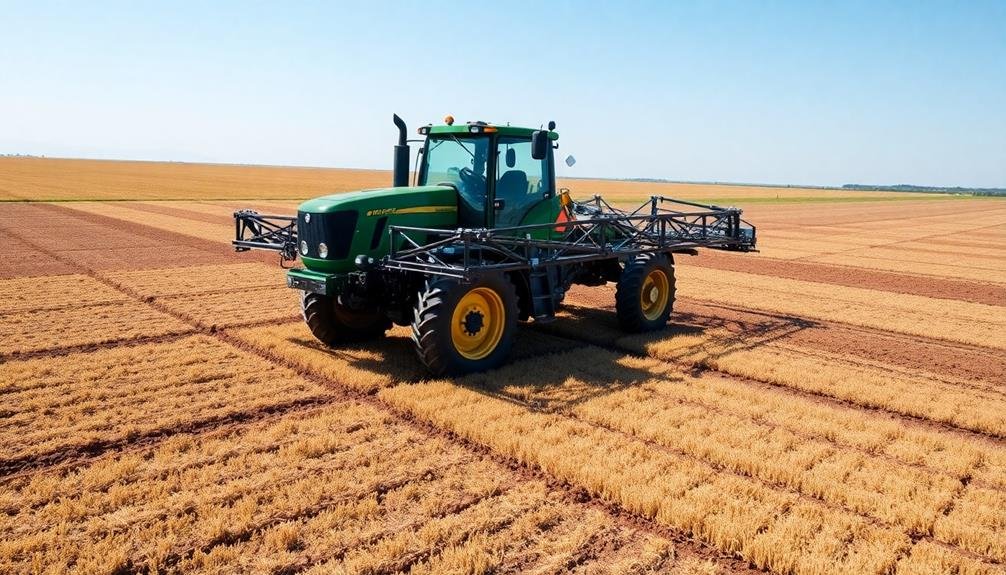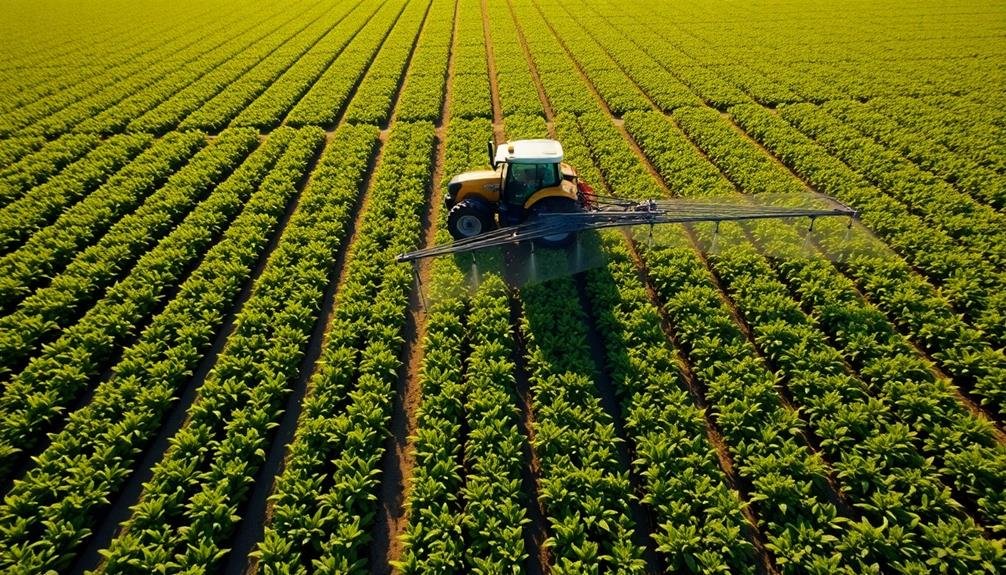Precision farming revolutionizes agricultural spraying with three cutting-edge techniques. Variable Rate Application tailors input application to specific crop needs using GPS and digital maps, maximizing efficiency. Spot Spraying targets individual plants or areas, using advanced sensors to reduce chemical usage by up to 80%. Swath Control Technology automates sprayer management, preventing overlap and minimizing waste. These methods markedly cut costs, boost yields, and reduce environmental impact. They work together seamlessly, optimizing spraying operations for modern farmers. By embracing these innovative approaches, you'll release the full potential of precision agriculture in your fields.
Variable Rate Application

Three key components define Variable Rate Application (VRA) in agricultural spraying: precision, efficiency, and customization. VRA allows you to apply inputs like fertilizers, pesticides, and herbicides at varying rates across your field, based on specific crop needs and soil conditions. By using GPS technology and digital maps, you can target areas that require more or less treatment, reducing waste and maximizing resource use.
To implement VRA, you'll need a compatible sprayer equipped with controllers that adjust application rates on-the-go. You'll also require accurate field data, including soil samples, yield maps, and satellite imagery. This information helps create prescription maps that guide your sprayer's output.
VRA offers numerous benefits. You'll save money by reducing input costs and improving crop yields. It's environmentally friendly, as you'll minimize chemical runoff and overuse. You'll also enhance crop quality by providing precise nutrient management.
However, VRA requires initial investment in equipment and training. You'll need to stay updated on technology advancements and regularly calibrate your systems for peak performance. Despite these challenges, VRA remains a cornerstone of precision agriculture, offering substantial long-term benefits for your farming operation.
Spot Spraying

While Variable Rate Application offers broad-scale precision, Spot Spraying takes targeted application to an even finer level. This technique allows you to apply chemicals only to specific areas or individual plants that require treatment, markedly reducing overall pesticide use and environmental impact.
To implement spot spraying, you'll need advanced sensing technology. Optical sensors or cameras mounted on your sprayer can detect weeds or pest-infested plants in real-time. These sensors differentiate between crops and unwanted vegetation based on color, size, or shape. When a weed is identified, the system triggers a precise spray application, often within milliseconds.
You'll find spot spraying particularly useful in situations where weed distribution is patchy or when dealing with herbicide-resistant weeds. It's also effective for applying fungicides or insecticides to isolated problem areas. By using this method, you can potentially reduce chemical usage by 60-80% compared to broadcast spraying, leading to considerable cost savings and decreased environmental impact.
To maximize spot spraying's effectiveness, you should regularly calibrate your equipment and keep sensors clean. You'll also need to verify your sprayer can respond quickly to sensor inputs for accurate application.
Swath Control Technology

In the domain of precision agriculture, Swath Control Technology stands out as a game-changing innovation. This advanced system uses GPS and mapping software to automatically control individual nozzles or boom sections on your sprayer. As you navigate your field, it prevents overlapping or skipping areas, ensuring precise application of chemicals or fertilizers.
You'll find that Swath Control Technology offers numerous benefits:
- Reduces chemical waste and overuse
- Minimizes crop damage from over-application
- Increases efficiency and saves time
- Lowers input costs and improves profitability
- Enhances environmental stewardship
By implementing this technology, you're taking a significant step towards more sustainable and efficient farming practices. It's particularly useful for fields with irregular shapes, obstacles, or varying terrain.
You'll notice improved accuracy in your spraying operations, especially when working around waterways, field boundaries, or previously sprayed areas.
Swath Control Technology integrates seamlessly with other precision farming tools, such as variable rate application systems. This synergy allows you to optimize your spraying operations further, tailoring application rates to specific field zones based on soil types, crop health, or yield potential.
Frequently Asked Questions
How Does Weather Affect the Effectiveness of Agricultural Spraying Techniques?
Weather greatly impacts your spraying effectiveness. Wind can cause drift, while rain may wash off chemicals. Temperature affects evaporation rates. Humidity influences droplet size. You'll need to adjust your techniques based on current conditions for ideal results.
What Safety Precautions Should Farmers Take When Handling Agricultural Spraying Equipment?
You should always wear protective gear, including goggles and gloves. Don't forget to read equipment manuals and follow safety guidelines. Maintain your sprayers regularly, and never ignore warning signs or leaks. Store chemicals properly and safely.
Are There Organic Alternatives to Chemical Sprays for Precision Farming?
Yes, you've got organic options for precision farming. You can use biological controls like beneficial insects, employ cultural practices such as crop rotation, or apply natural substances like neem oil and compost teas for pest management and soil health.
How Often Should Spraying Equipment Be Calibrated for Optimal Performance?
You'll want to calibrate your spraying equipment regularly. It's best to do it before each application season and whenever you change products or rates. Don't forget to recalibrate after repairs or nozzle replacements too.
What Are the Environmental Impacts of Different Agricultural Spraying Methods?
You'll find that different spraying methods have varying environmental impacts. Aerial spraying can cause drift, affecting non-target areas. Ground-based methods may lead to soil compaction. Precision techniques reduce chemical use, minimizing water and soil contamination.
In Summary
You've now explored three cutting-edge spraying techniques for precision farming. By implementing Variable Rate Application, Spot Spraying, and Swath Control Technology, you'll greatly improve your farm's efficiency and sustainability. These methods will help you reduce chemical usage, minimize environmental impact, and boost crop yields. Don't hesitate to adopt these technologies; they're the future of agriculture. As you move forward, remember that precision farming isn't just about technology—it's about making smarter, data-driven decisions for your farm's success.

As educators and advocates for responsible drone use, we’re committed to sharing our knowledge and expertise with aspiring aerial photographers.




Leave a Reply